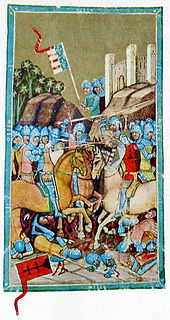Hungarian minor kingdoms
The Hungarian minor kingdoms were territorial lords in Hungary at the beginning of the 14th century. As 1301 with King Andrew III. the last of the male line of the Árpáden family died, Hungary, which had been a unit until then, was divided into several minor kingdoms. The rulers of these small kingdoms were the oligarchs and oligarch families Matthäus Csák , Joachim Gutkeled , Omodej von Aba, Jakob Borsa Kopasz, Ladislaus Kán, Stefan Ákos, Nikolaus Pok and the lords of Güns . In the 1320s, King Charles I Robert ended the power of the oligarchs in a series of campaigns and restored central power.
Emergence
Large numbers of farmers began to immigrate to Hungary at the end of the 12th century. The Hungarian villages were organized according to German law, which increased the yields of the large estates and thus the power of the aristocracy .
The castles of the country belonged to this time with a few exceptions, the king greeted by his Gespanen (comites) managed. After the Mongol storm in 1241, King Béla IV encouraged the aristocrats to build castles. At least 70 new castles were built between 1242 and 1270, 55 of them by the aristocrats. This also increased the political and military influence of the aristocratic landowners.
From 1262 onwards there was armed hostility between King Béla IV and his son Stephan V and with it a steady breakdown of the central power of the king. In order to secure powerful followers, father and son gave goods to the aristocrats, which brought in this additional gain in power. Most of the beneficiaries were direct employees of the king and his son, who held state offices and court offices like the palatine and Gespane.
At first there were dozens of aristocrats who owned more than one castle. Since, according to Hungarian legal custom, the property had to be divided among the sons after the death of the father, the property remained in the family. This legal practice as well as the transfer of castles through purchase and violent conquest resulted in a concentration of power on fewer and fewer families.
The time of the oligarchs

Most of Hungary was divided into counties , headed by a clan who received a third of the royal income from the county and who was in command of the county castle. In contrast, certain areas such as Slavonia were placed under a viceroy appointed by the king (Palatine and Banusse ). The viceroys exercised all royal functions as chief judges, administrators and generals. Most of the incumbents were also allowed to choose their representatives. The offices were not hereditary at this time.
As palatines, banuses, voivodes and Gespane, the oligarchs held the highest offices in the country and thus also had legitimized power over their domains. They ran their own court with their own chancellery and established diplomatic and marital relationships with foreign powers. And although they even acted largely independently of the king in terms of foreign policy, these Hungarian “petty kings” did not take any steps to put an end to the institution of kingship .
Fügedi, for example, counters the efforts of the oligarchs for their own principalities, which are sometimes suspected in history, as follows. In Hungary, kingship had been deeply rooted for 300 years and the oligarchs did not have enough time to divide the united kingdom into small states. The Hungarians were used to always having a king under the St. Stephen 's crown and the oligarchs needed the king to legitimize their official title. In conflicts with the king they either looked for a settlement or they looked for another monarch, from whom they hoped to be able to influence him more easily. In addition, the oligarchs were often involved in armed conflicts among themselves and repeatedly made use of the king.
King Charles I Robert undertook a series of campaigns against the oligarchs. He achieved a decisive victory in 1316 against the particularly rebellious Günser lords. He destroyed Somogyvár, conquered the fortresses Nyék , Tamási and Tolnavár and then took Kőszeg , the main fortress of the Günser. Until then, the king's sphere of influence was essentially limited to the southern part of the kingdom from Pozsega to Transylvania . Elsewhere, for example around Ofen and in the Zips , he had only remote and isolated bases. In the 1320s, Charles I Robert finally restored the central power of the kingdom.
literature
- The Güssinger. Results of the symposia in the context of the “Schlaininger Talks” 1986/1987, published by the Burgenländisches Landesmuseum Eisenstadt, Eisenstadt 1989.
- Majoros Béla: Kiskirályok Magyarországon (in Hungarian, German: Hungarian minor kingdoms), 2013, ISBN 978-615-5358-01-2 . Reading sample
Web links
- Map “The Oligarchical Hungary 1301-1310” in the Electronic Hungarian Library http://mek.niif.hu , accessed on October 27, 2010
Individual evidence
- ↑ Erik Fügedi: Castle and society in medieval Hungary (1000-1437). Budapest 1986, pp. 50-99.
- ↑ Erik Fügedi: Vár és társadalom a 13-14. századi Magyarországon , (German castle and society in Hungary in the 13th and 14th centuries), Budapest 1977, p. 31.
- ↑ Erik Fügedi: The rule of the Güssing people in terms of social history , in "The Güssinger" results of the symposia in the context of the "Schlaininger Talks" 1986/1987, publisher Burgenländisches Landesmuseum Eisenstadt, Eisenstadt 1989, p. 23 ff.
